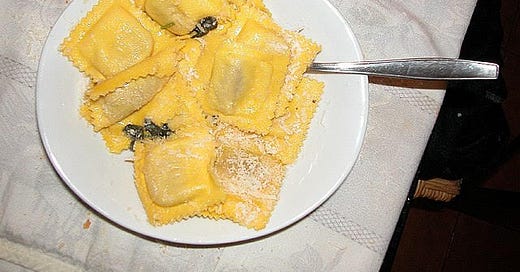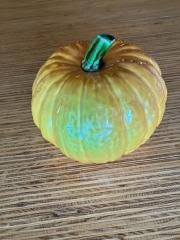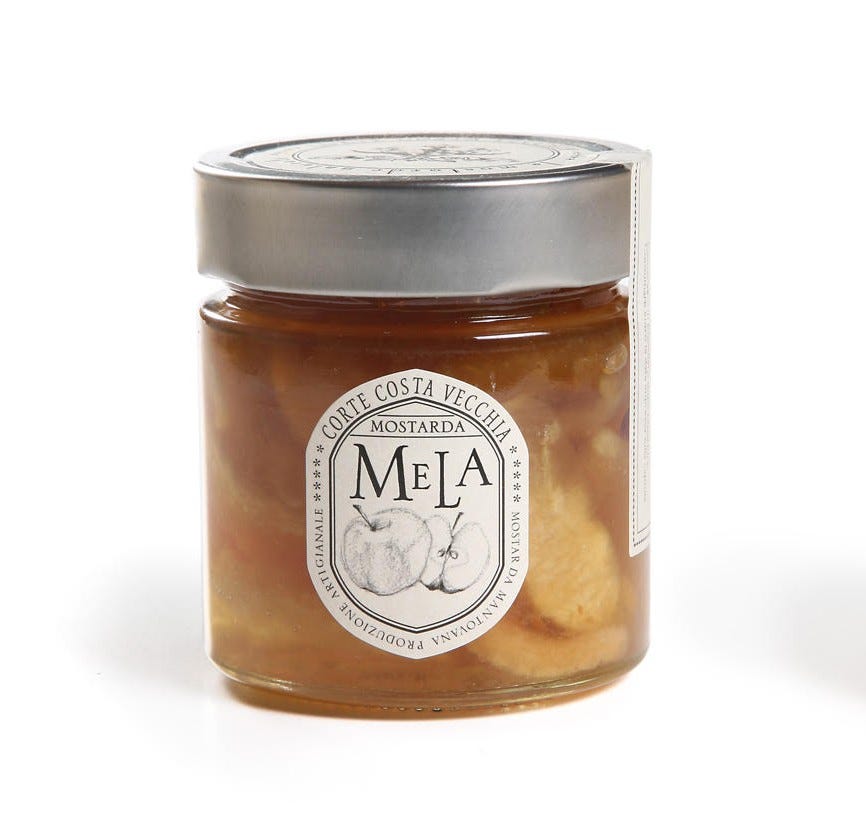At this time of year our pumpkin gets a place of prominence in our apartment. We got it years ago in Bassano del Grappa, one of Italy's ceramic towns among others like Orvieto, Faenza, Vietri, and Deruta. We picked it up at the beginning of a trip, so I had to carefully carry it the whole time and on the plane back to New Mexico, but it was worth the hassle.
This is not a food column. There are plenty of Substacks about Italian cooking, many of which I read regularly. But I write about Italy and mystery writing, and where they coincide, not about food. However, since Thanksgiving is coming up in a couple weeks I could not resist consideration of one of the staples of the holiday table, though from the perspective of an eater and not a chef. And we're talking about the Italian table, so at least I'm staying true to my Italian theme.
The zucca wasn't always found in Italian cuisine, of course. Like the tomato, the squash came from the Americas, brought to Europe after 1492. Now it is a regular on Italian menus, especially in the north, and most prominently in Lombardia. My first encounter with it was when I was working out of the consulate in Milan, and my territory included Cremona and Mantova, two cities where the zucca is a popular ingredient. That dish that got me hooked was tortelli di zucca.
I will confess that the idea of sweet pumpkin in pasta did not sound to me like a good combination, but I was immediately won over by having it at what is still one of Mantova's premier restaurants, Il Cigno. Tucked away on a back street – Mantova is full of back streets – Il Cigno was (and still is) a classic Mantovano restaurant, very elegant and understated, its dining room overseen by a quiet man always sporting a bow tie. The key, of course, is in the ingredients, starting with paper-thin fresh pasta. Besides the pumpkin, the filling includes crushed amaretto cookies and mostarda mantovana.
Mostarda is not mustard (which is senape in Italian), it is a condiment made from candied fruit, though there is dash of mustard flavor in its recipe. Apple is usually the preferred fruit in the mostarda of Mantova. Over these wonderful tortelli is melted butter and ground almonds. If you've never tried it you may be thinking that with pumpkin, candied fruit, butter, and almonds, aren't there too many rich flavors on one plate? Not at all, it works very well indeed.
As you might expect, when my protagonist, Rick Montoya, finds himself in Mantova in the fifth book in the series (A Funeral in Mantova), he enjoys a meal at the Cigno and orders tortelli di zucca as the first course for him and the comely Lexi Coleman.
The Mantovani will say their tortelli di zucca are the best, of course, but the Cremonesi down the road will dispute that. There are even some people who say that the best ones are found in Ferrara, but nobody in Lombardia really takes them seriously.
There was another pumpkin dish that I was introduced to in Milan, and it was nothing I had expected. It was fiori di zucca fritti, deep fried pumpkin flowers. The flowers are stuffed with mozzarella cheese and usually anchovy, then lightly dipped in batter and deep fried. The result is a crunchy on the outside and melty in the center.
What about pumpkin pie? I never saw it on menus in Italy, which is a shame, since Italian chefs can probably make it as well, or perhaps better, than the ones we get in America.
Happy Thanksgiving, and buon appetito.








Ohhh, you've made me hungry now. If we ever get stuck on a deserted island, bring your key board, please. We'll be the best-fed castaways in history. The other thing I have an appetite for is your next Rick mystery. Will it be published soon? Your Arizona Book Club awaits you....